There’s little doubt that I go through long periods where I’m photographing the same kinds of subjects – usually not intentionally, except insofar that I’m not making a specific effort to get more variety in. It’s been bugs, and frogs, and birds, and even aquatic macro at times; just recently it’s been the lizards and occasional other denizens of the property after nightfall, and this was partially because that was when I had the time and inclination to chase some pics. So today, when a red-shouldered hawk (Buteo lineatus) landed on a nearby dead branch and was calling enthusiastically, I took advantage of it. Full credit to the bird for staying put long enough for me to get the camera and long lens.
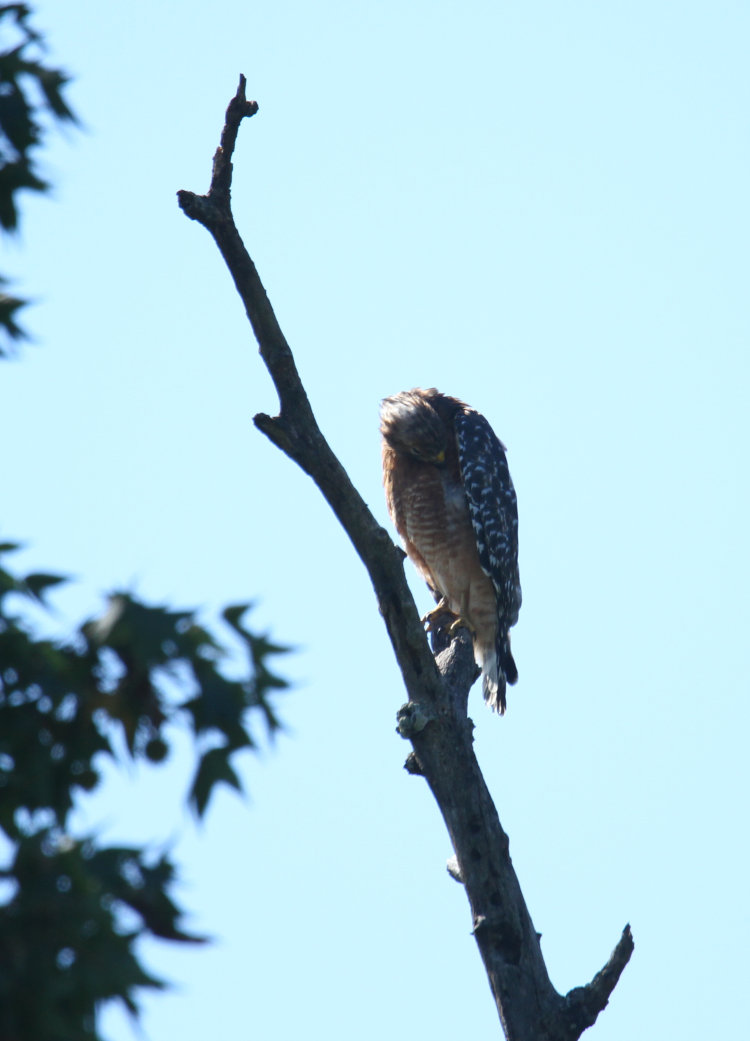
Last winter we had a pair visiting regularly, at least one of which was routinely hunting right in the front yard, and they even began a nest in a tree in the back yard. But then shortly before laying season they abandoned it, and appeared to have picked a spot a few hundred meters further south out of sight to nest. All summer, it’s been largely quiet with only occasional visits, but now they appear to be starting up again. This one took a short break from its calling to try to clean out some old feathers, none too efficiently.
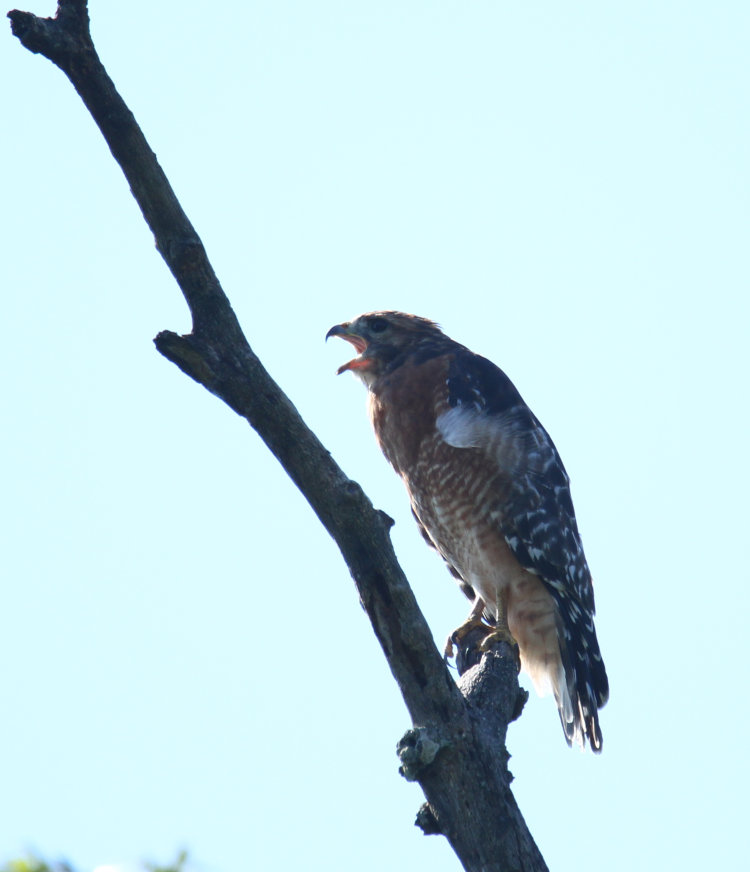
The angle that I had was too close to directly into the light – this is over-exposed a full 2 stops over what the camera was metering for, which was the sky itself, the hawk being too small in the frame to affect exposure sufficiently (these are also cropped, of course.) You can see the stray feather still sitting there against the wing. These images also told me (again, not that I needed any reminder) not to base exposure compensation on what the LCD showed in the preview, because they looked too dark there, but I knew more than 2 stops would be excessive.
I was hearing another red-shoulder in the distance, which is not unusual since they routinely mark territory, but after a few minutes it started coming within a hundred meters. Rather than taking flight to challenge an interloper, this one remained in place but continued calling, the calls getting softer and more half-hearted, almost muttering, when the other drew close. As suspected, that one was the Significant Other, and soon came in for a landing.
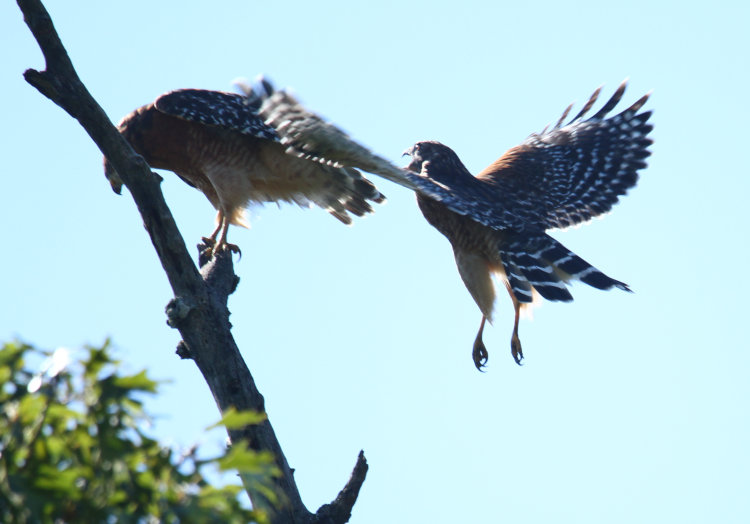
Telephoto compression makes them look about ready to collide here, but there’s still a decent separation between them. I’m kind of lucky autofocus tracked as well as it did, because I shifted over to catch the new one approaching but didn’t frame well enough until he was quite close to the original – my view was largely blocked by trees in that direction.
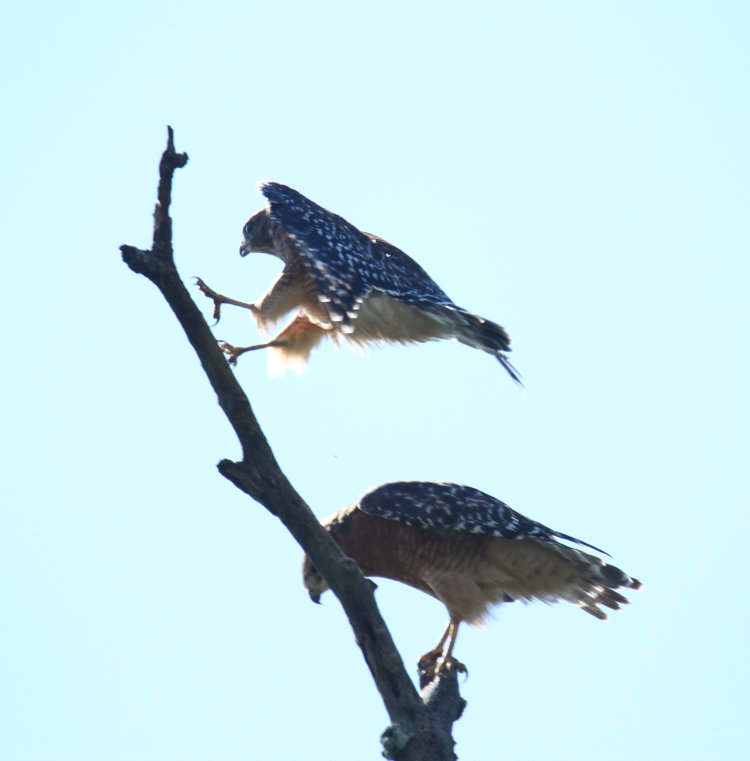
And touchdown – yes, the first hawk probably really is ducking just to avoid getting slapped with wings or tail.
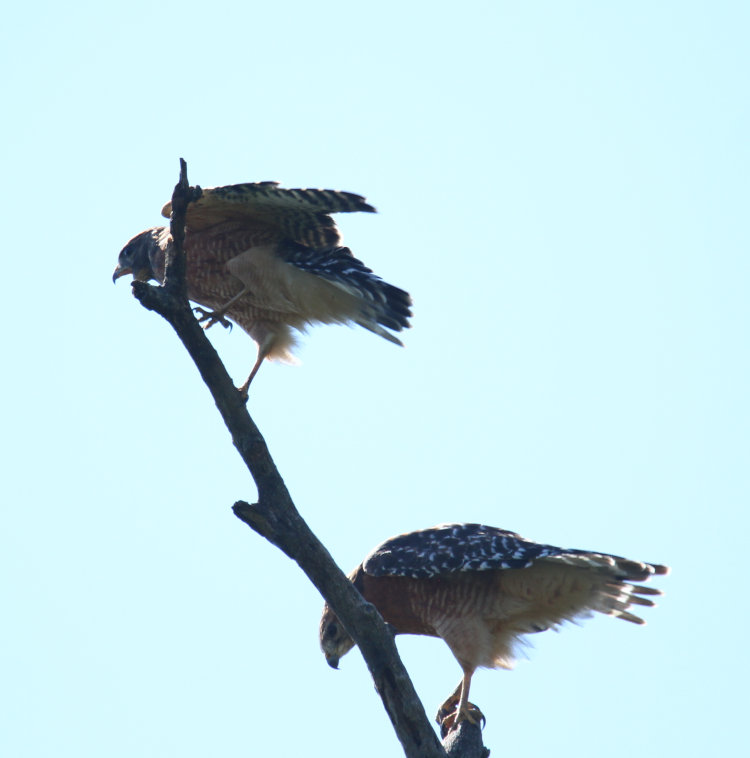
Next frame in the sequence as I held the shutter down – you can see the new one is already sounding off again, even though the reunion meant that they both got a lot quieter and stuck to minor vocalizations from this point on.
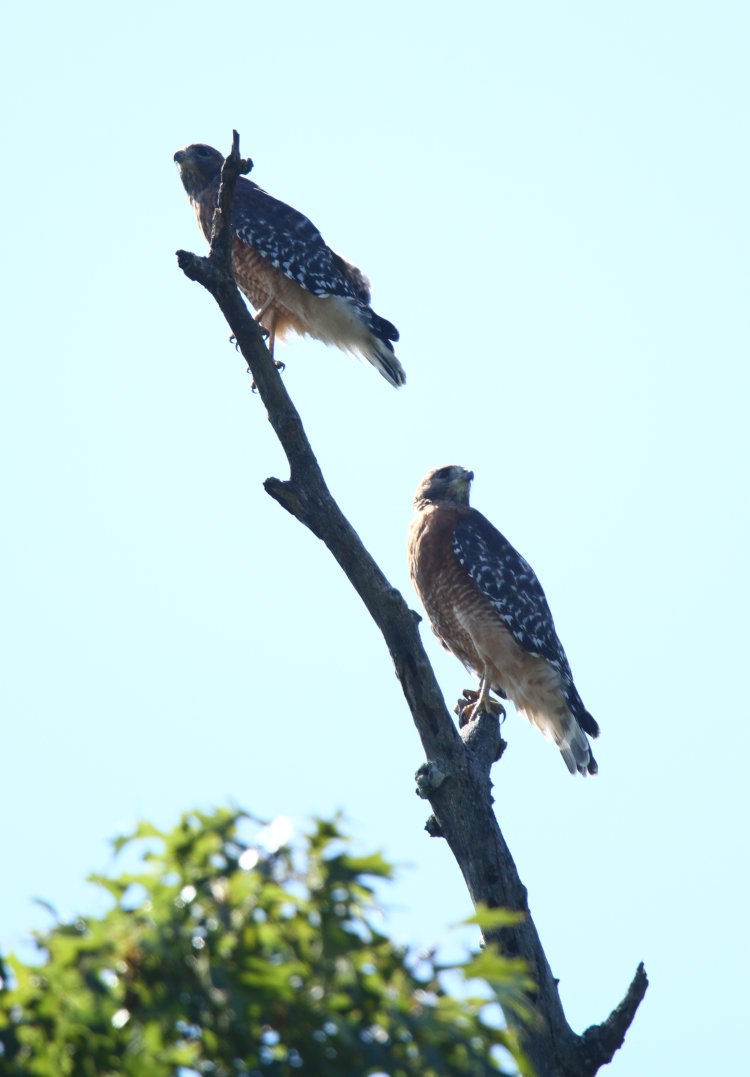
I did get a nice portrait of the two of them, and this image shows the size difference well enough; it’s likely the female down below, the first one spotted, since they’re typically a little larger than the males for most raptors.
Now, is this the same pair that we observed through the winter? Can’t say for sure. Even if it is, I’m not even sure that they raised any young, but given their penchant for remaining a little further south until now, when the young should be off on their own and even chased away from the territory, there’s the tiniest indication, but that’s all; we never saw any sign of child-rearing or obvious juveniles.
Since they were staying put, and because we’ve had a history of the winter pair not being too disturbed by people nearby, I started moving across the yard to see if I could get a view from the sunny side. This required getting a bit closer, and before I managed to bring the branch back into view past the intervening trees, they took flight again – this could have been my doing, or it might simply have been when they decided to stop sitting around. They circled out over the pond a couple of times and gradually moved further off, and while I fired off several frames as they circled, autofocus wasn’t locking on very well, so this is the only truly sharp frame that I got:
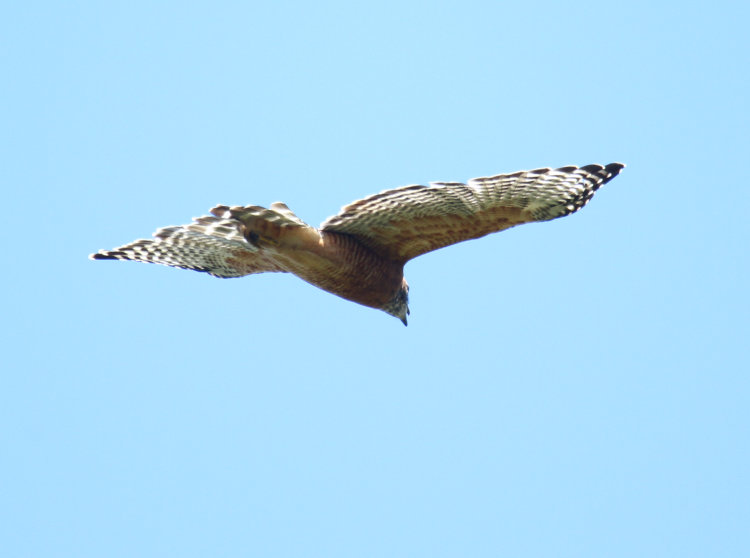
Yep – sounding off again; red-shouldered hawks can be damn noisy raptors.
So, we’ll see what happens from here. While we were sorry to see the nest get abandoned in the early spring, soon afterword the wood ducks started descending on the yard in large numbers, which was a more than decent tradeoff. Back in May, one red-shoulder returned to the yard for a few days, apparently hunting the wood ducks, and actually killed one not too long after we knew it was hunting here.
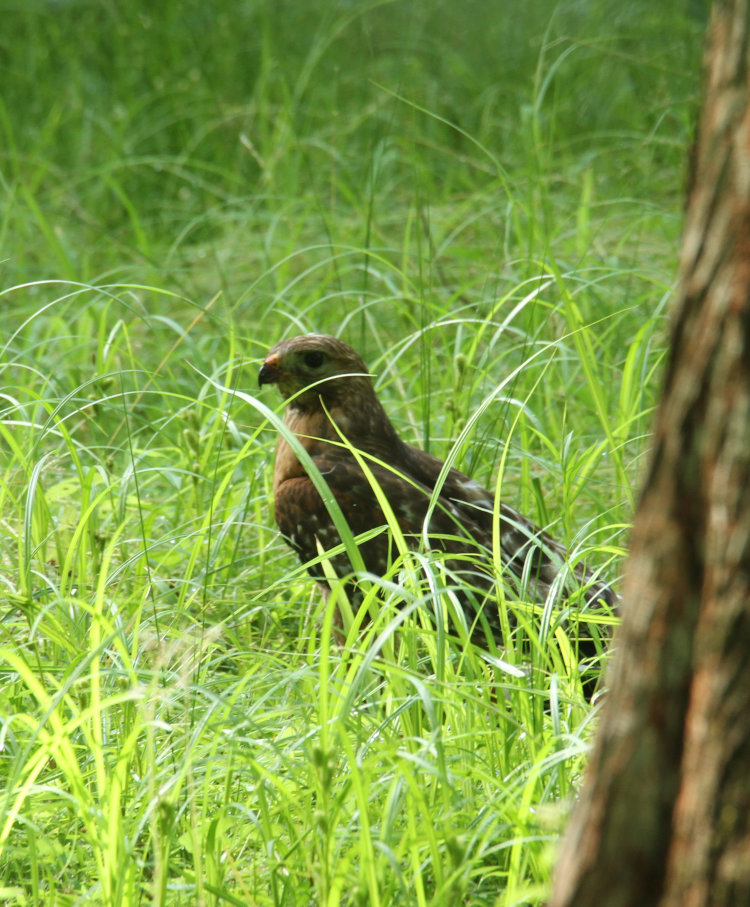
You can’t see its prey here, but we confirmed it was a female wood duck after I spooked it off – it later returned to take the carcass away. Naturally, this did not go over well with The Girlfriend, who took to clapping together a couple of wood blocks every time she heard a hawk nearby, a sound loud and sharp enough to keep them from the immediate area. The wood ducks, for their part, got a lot more wary, and we started putting corn down only at the very edge of the yard near the water, reasoning that the ducks could get over water much quicker and the hawk was less likely to try and snag one there, being unable to ground their capture (wood ducks are too large for a red-shouldered hawk to easily kill and carry off while in flight.) There were no other losses to our knowledge, but now we’ll have to see what happens.
[So okay, balance of nature and this is how things go, even hawks have to eat, but we were also creating a feeding station in the yard, so we were implicit in making the ducks more of a target. And yes, we like the ducks better – sorry, professional detachment doesn’t go that far. Sue us.]



















































